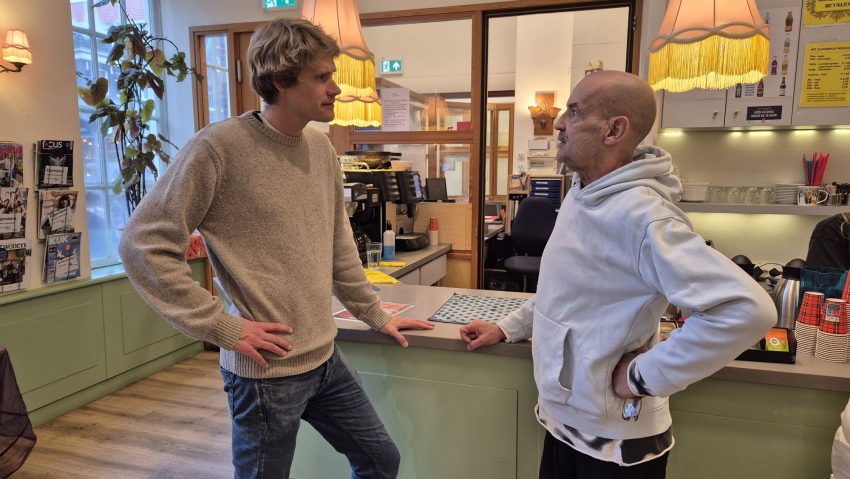Starting with learning Dutch might just be the most difficult part of learning the language. Being afraid of mispronouncing a word, everyone you meet is speaking English, or having trouble with thinking of what to say.
These are just a few examples of thresholds that might keep you from starting with learning Dutch. That’s why we’re here to provide you with some basic Dutch sentences, which you’ll find in almost every conversation.
In this blog, I’ll take you with me to a conversation I had with Cello at our community center. Did you know that Cello used to be in a boy bond when he was younger?
We were talking about Koetjes en Kalfjes 🐄 (small talk or chit-chat) and used a lot of everyday phrases along the way. During the conversation I’ll let you in on why I used that particular phrase, and more importantly, what it means.
Dutch phrases in every small talk
When I walked into the community center, I was greeted by a very enthusiastic Cello.
👨🏼🦲 Cello: “Hey! Hoe gaat het?”
📋 Translation: “Hey! How are you?”
👉🏻 Used when you greet someone, whether you saw them yesterday or a month ago, it makes no difference.
👱🏻 Me: “Good! Although I had to walk here, since my tram got cancelled.”
👨🏼🦲 Cello: “Dat meen je niet!”
📋 Translation: “You can’t be serious!”
👉🏻 A way to express that you are shocked or can’t believe it. It‘s also used to tell someone how sorry you are for them.
👨🏼🦲 Cello: “How are you going to get back when you are done? Also on foot?”
👱🏻 Me: “Maak je geen zorgen. Het komt goed! I’m sure the trams will be back on track when I’m done.”
👉🏻 Here I used two phrases in a row. Let’s go through them step by step.
📋 Phrase 1: “Maak je geen zorgen.” Which translates to: “Don’t worry.”
Locals often shorten it to “Geen zorgen”, which means the same as the original.
📋 Phrase 2: “Het komt goed.” This translates to: “It’ll be fine.”
We use this to tell someone there is nothing to worry about, or to comfort them.
👨🏼🦲 Cello: “Hmm, not sure if the trams will be running again when you’re finished. Even kijken.”
📋 Translation: “Let’s see” or “Let me check.”
👉🏻 ‘Even kijken’ is a sentence that Dutch people use quite often.
👱🏻 Me: “Ja, ik ben het met je eens.” “But you don’t have to check! Thank you anyways.”
📋 Translation: “Yes, I agree with you.”
👨🏼🦲 Cello: “Geen probleem, doe de groetjes aan je collega’s!”
📋 Translation: “No problem, say hi to your colleagues!”
👉🏻 Here I once again used two Dutch sentences. The first one, ‘Geen probleem,’ means No problem. The second sentence, ‘Doe de groetjes aan…,’ means Say hi to…
👱🏻 Me (while walking away): “Zal ik doen!”
📋 Translation: “I will do!”
Why these Dutch phrases are important
The phrases I just showed you in the conversation are very useful in everyday conversations. They are some of the basic sentences used in greetings and small talk, or when we talk about koetjes and kalfjes. These can help you communicate with other people right away. Even if you only know a few words, you can make yourself understood and follow what others are saying.”
These simple sentences also help you integrate into Dutch culture easier. They are, of course, only words, but every culture uses specific sentences in specific situations. Dutch people use these sentences every single day.
Furthermore, most chit chat conversations consist of just a few basic sentences that carry the conversation a long way. These are of course not all the sentences you will need, but they’ll get you a long way.
Learning Dutch phrases with Koentact
As said before, these phrases won’t be enough to get you all the way there, but they sure do help a lot! Want to learn more basic phrases that will help you integrate into Dutch culture quicker? We are happy to invite you to our Open Day. Between each course session, we have an Open Day that offers a free trial class, free level assessments, and a small introduction into the Koentact way of learning Dutch.
If you have any questions, or are simply curious, we’d love to see you at our Open Day!

